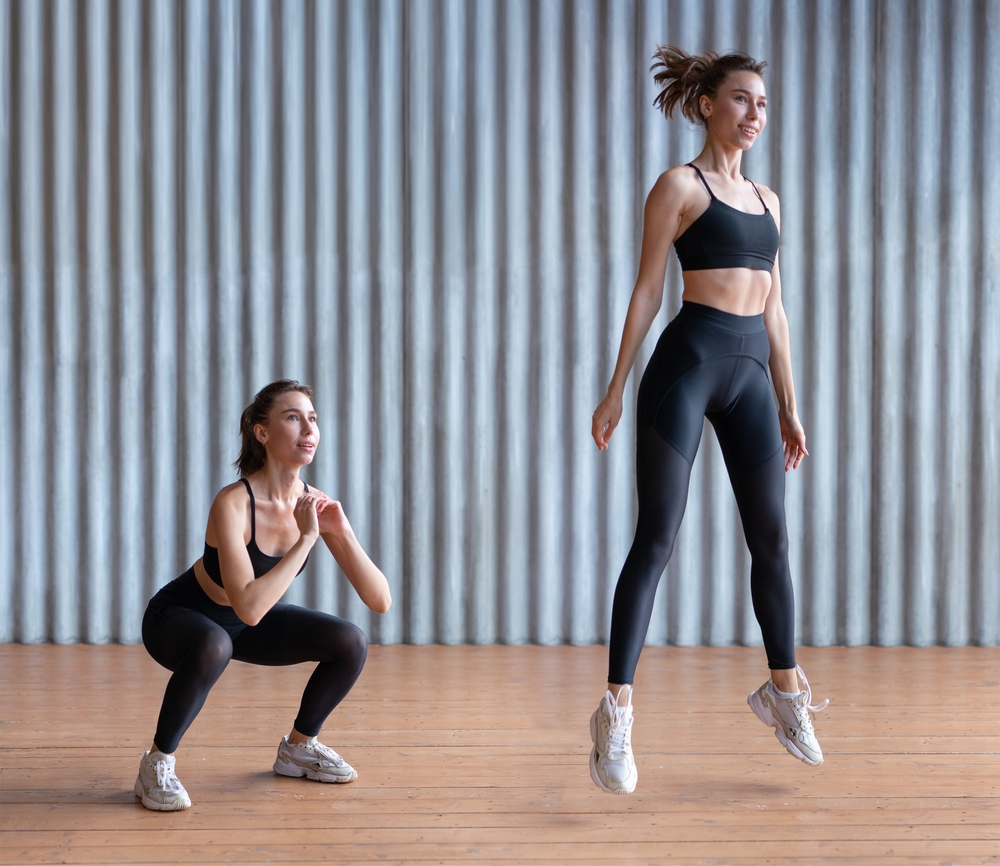A Detailed Guide on Types and Benefits of Jump Squats
Jump squats are a high-intensity exercise that you can perform to shed those extra pounds and remain athletic. The benefits of jump squats are countless. Read on.
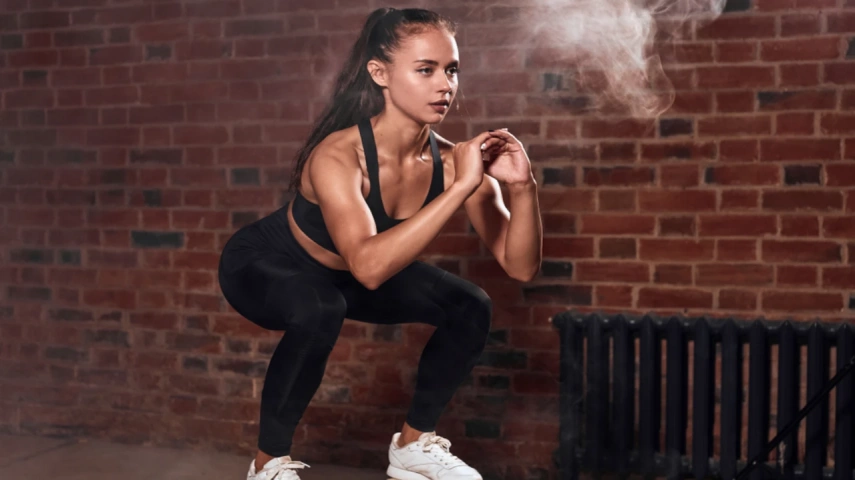
Jump squats are one of the most simple, popular, but demanding exercises. If you want to ace your cardio game, try jump squats. Most gym trainers believe that no workout session is complete without squats and for a good reason. Squats are a compound movement workout that involves multiple muscle groups in the body. The high-intensity exercise mainly focuses on the glutes, quads, hamstrings, and abs, thus making a wonderful lower-body workout. The benefits of jump squats extend to helping in shedding excess flab, strengthening hips & thighs, and improving balance (1), (2), (3). While the standard up-down movements of a regular squat can deliver long-lasting results, let’s find out if performing jumping squats offer any added advantages. Read on to learn how different they are from regular squats, and how to perform jump squats for better results.
Top Benefits of Performing Jump Squats Everyday
Our contributor Dr. Allen Conrad, Doctor of Chiropractic at Montgomery County Chiropractic Center, says, “Jump squats are a good exercise for improving explosive power and strength. You would want to do these at the beginning of a workout, as they require a great deal of power, strength and muscle endurance. They also incorporate balance, so try them when you start the workout. If you do them at the end of the workout when you are fatigued, you won't get the same explosive strength benefit.”
Both normal squats and jump squats make an excellent exercise to build lower body strength; the latter adds more cardio components and helps burn more calories. The jump squat is similar to normal squats but they are followed by a light jump after each round. Let’s take a look at the best jumping squats benefits for better athletic performance.
Burn More Calories and Body Fat
Jump squats are known to increase your body’s basal metabolic rate - the rate at which your body burns calories when at rest. Performing 30 jump squats may help you burn around 100 calories depending on your current body mass index and the intensity of the jump squats. Women are more likely to suffer excess fat accumulation in the lower body and incorporating squats jump in your daily exercises may help tone the muscles in the lower body and shed excess fat in hips and thighs.
Strengthens Your Core
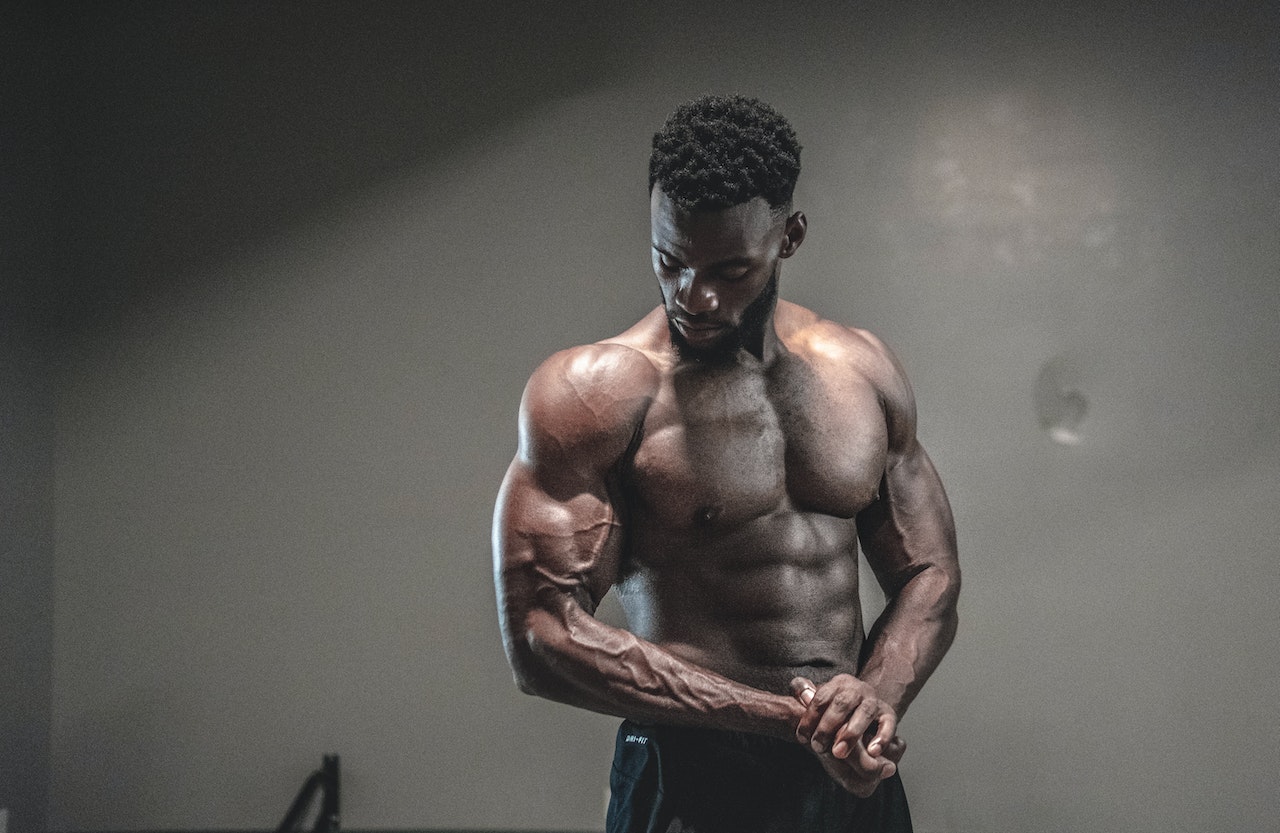
Having strong muscles makes performing daily activities like standing, walking, or bending super easy, plus they improve your athletic performance along with your quality of life. Not only does a stronger core help balance your body but reduces the risk of lower back pain. Besides, it helps maintain the perfect body posture.
According to a 2018 study, it is found that core muscle activation during a plank with back squats led to greater activation of core muscles to support the back in subjects (4). Besides, jumping increases your muscle strength and body’s natural potential to balance. Doing squats jump exercises may help reverse the natural weakening of the muscle groups in your lower body. Improved muscle strength helps maintain motor balance and facilitates better brain-muscle communication for improved sports endurance.
Our contributor Dr. Allen Conrad says, “Jump squats are an advanced type of high impact exercise that can improve athletic performance. They can help improve power and speed for certain sports like rugby and football. However, they are not for the beginners, and people with degenerative knee conditions should not attempt these.”
Lowers The Risk of Injuries
When your body’s core muscles are strengthened, you are more likely to execute whole-body movements including walking, bending, and stretching with better endurance, mobility, focus, and balance. Also, incorporating squats in your workouts routinely strengthens the glutes, tendons, and ligaments in your lower body, thus resulting in a lower risk of injuries.
Uplifts Athletic Endurance and Strength
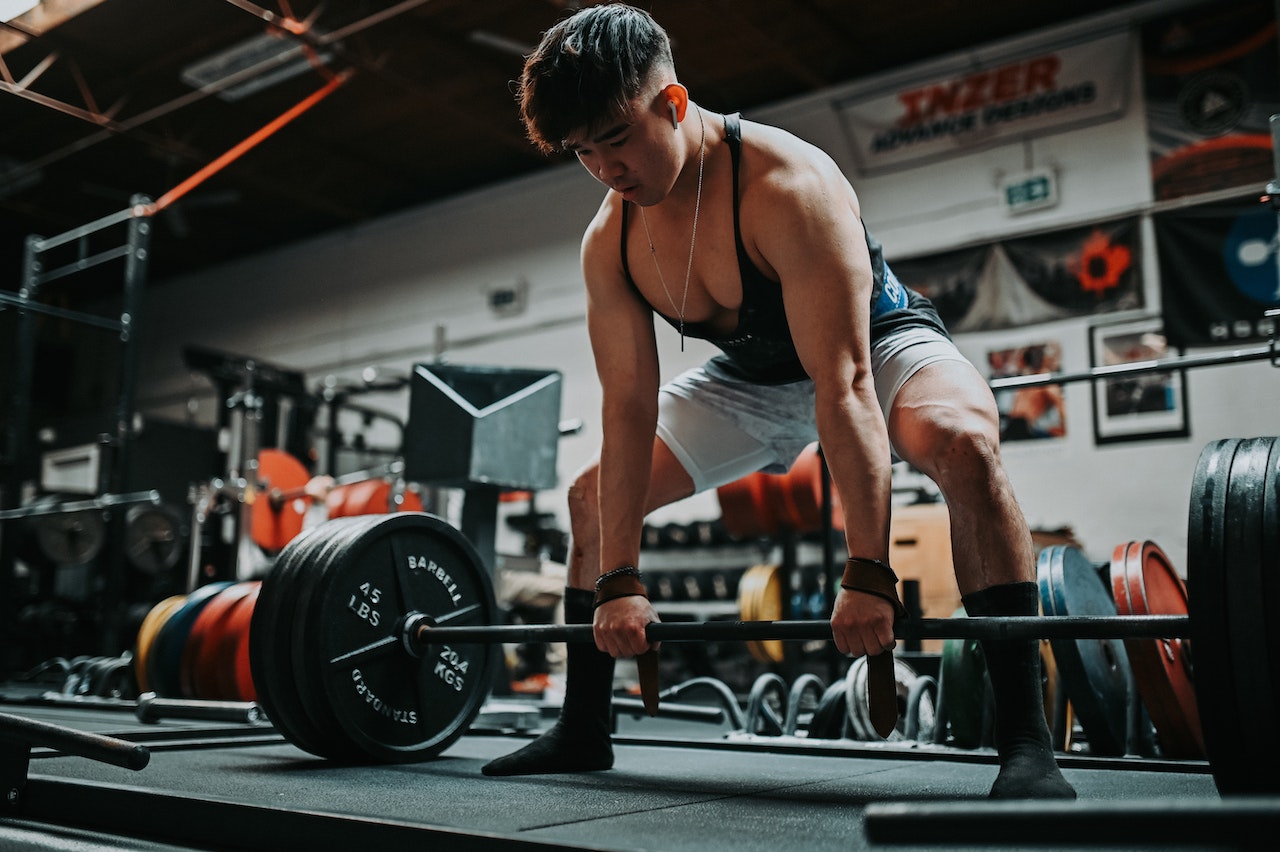
If you often indulge in sports activities, adding jump squats to your daily workout routine may help you develop immense strength and speed, which may eventually improve your athletic endurance.
A 2016 study compared the effects of jump squat training done 3 times a week for over 8 weeks (5). The results indicated that the jump squat training has the potential to uplift athletic performances in different persons with explosive stamina and strength.
Improved Health
Staying active and moving more is the key to improving overall health. Regular exercises help regulate glucose & lipid metabolism and insulin sensitivity (6),(7). Performing high-intensity cardio exercises such as jump squats may lower the risk of cardiovascular ailments, obesity, and diabetes.
Variety Makes Workouts Exciting
Once you have mastered the art of performing basic squats, you can make your workouts by adding a variety of squats to your fitness regime. Changing up squats not only makes your exercise session much more interesting but helps you to strengthen and activate different muscle groups in the body.
You can perform squats with just your body weight or can add up some twists by using certain workout tools like dumbbells, kettlebells, yoga balls, resistance bands, or medicine balls.
Can Be Done at Home or the Gym
One of the best benefits of a jump squat is that you can easily perform it in the convenience of your home or under the supervision of your fitness trainer at the gym. All you need to perform a jump squat is enough space to bend your knees and lower your hips to a sitting position.
Besides, if you are always on the run and don’t get enough time to complete a set of 50 squats at once, you can divide them into a set of two - 25 squats each. Also, each set of jumping squats can be performed at different times of the day - 25 squats in the morning and the remaining 25 in the evening.
How To Do Jump Squats?
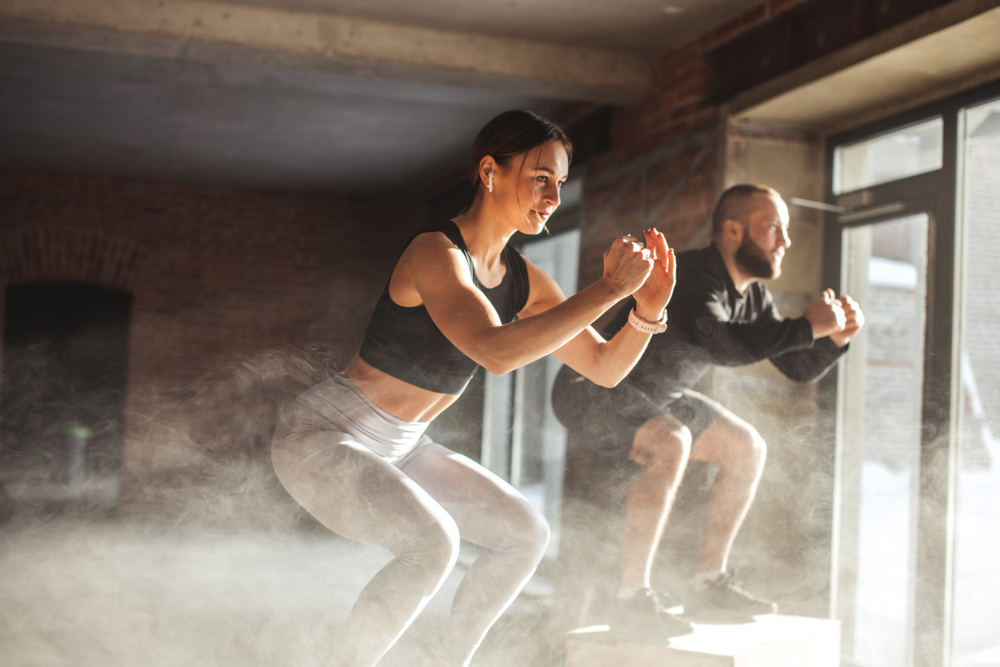
The jump squat is a plyometric move and doesn’t involve the use of special equipment. The powerful aerobic exercise requires you to exert your muscles to the core within a short time frame. The cardio exercise primarily targets the glutes, hamstrings, hips, and quads, simultaneously increasing your heart rate. Since jump squats put much pressure on your thighs and knees, ensure that the muscles in your lower body are strong enough to deal with the stress during the workout. If you have a weak lower body, it’s best to avoid jumping squats and switch to light exercises such as jogging.
Here is a step-by-step guide on how to perform jumping squats.
Step 1 - Stand straight upright and position your feet slightly wider than shoulder-width apart.
Step 2- Squat or bend down in a sitting position until your hips are slightly higher than your knees.
Step 3- Stretch your body upwards so that you lift off your heels from the ground.
Step 4- Touch down your heels, keep your knees bent, and settle back into the squat position.
Step 5- Upon landing, acquire the next squat position with a little jump.
Different Variations of Jump Squats
While most people misunderstand jump squats as an exercise that tones the muscles in the lower body, when done correctly, you can notice some pleasing results in your upper body as well. Squats are known to trigger testosterone and a boost of male hormone can increase muscle mass in all areas of your body. Here are a few common variations of jump squats that offer several benefits.
The Back Squats
The back squat is considered the ‘gold standard’ exercise when it comes to improving athletic endurance. It takes the traditional squat motion and involves a barbell to add resistance to the shoulders. The back squat targets the glutes and hips while focusing on the quads as well. Also, it required the coordinated interaction of several muscle groups in the body.
How To Perform The Back Squats
Step 1 - Place a barbell in a squat rack, ensure to keep it just below shoulder height.
Step 2 - Take a position underneath the barbell so that it is resting on your neck across the top of your back. Hold the barbell firmly with your hands.
Step 3 - Position your feet a little wider than the shoulder- width apart. Thereafter, step back to clear the rack.
Step 4 - Lower your body to take a squat position. Make sure to keep your hips below your knees.
Step 5 - Hold your body in this position for a few seconds. Now, press through your feet and stretch your body upwards to the starting position.
Weighted Squats
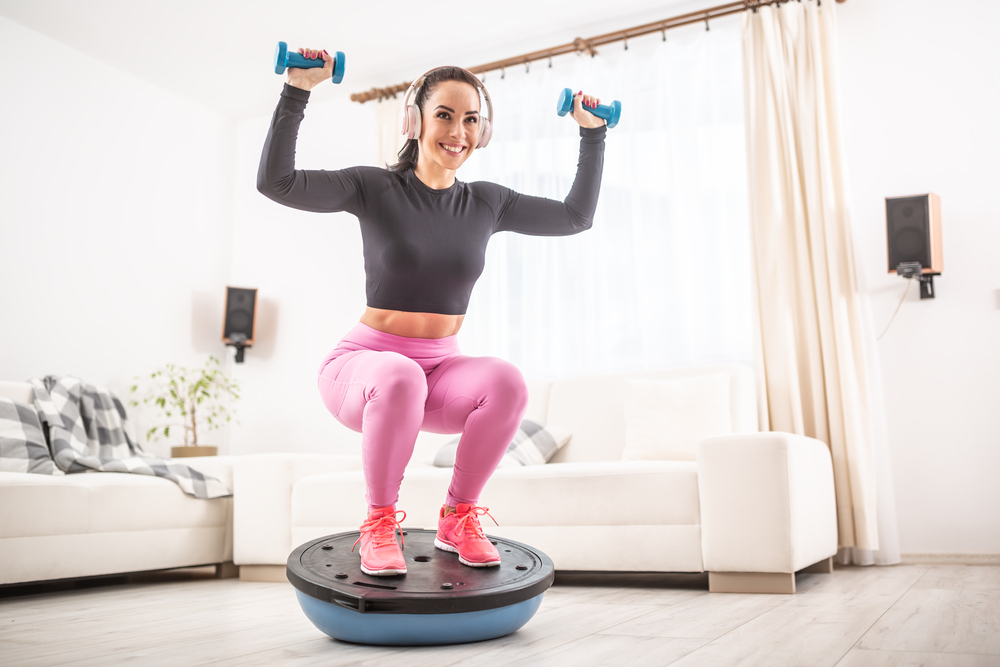
Weighted squats involve the use of weight equipment such as dumbbells that can be held in various positions such as on the shoulders, chest, or hanging on the sides. A typical dumbbell squat is performed with two dumbbells at your side. It targets your glutes, calves, and quads. Here is a stepwise guide on doing dumbbell squats.
Step 1 - Hold a pair of dumbbells and ensure to keep your elbows bent and palms facing each other.
Step 2 - Stand straight and keep your feet shoulder-width apart.
Step 3 - Take a squat-down position.
Step 4 - Stretch your body upwards. Lift your hands above your head as you take a jump.
Step 5 - Try to land in the same position and thereafter, bring your arms to normal resting position.
Step 6 - For best results, perform at least 2-3 sets of 15 repetitions every day.
Overhead Squats
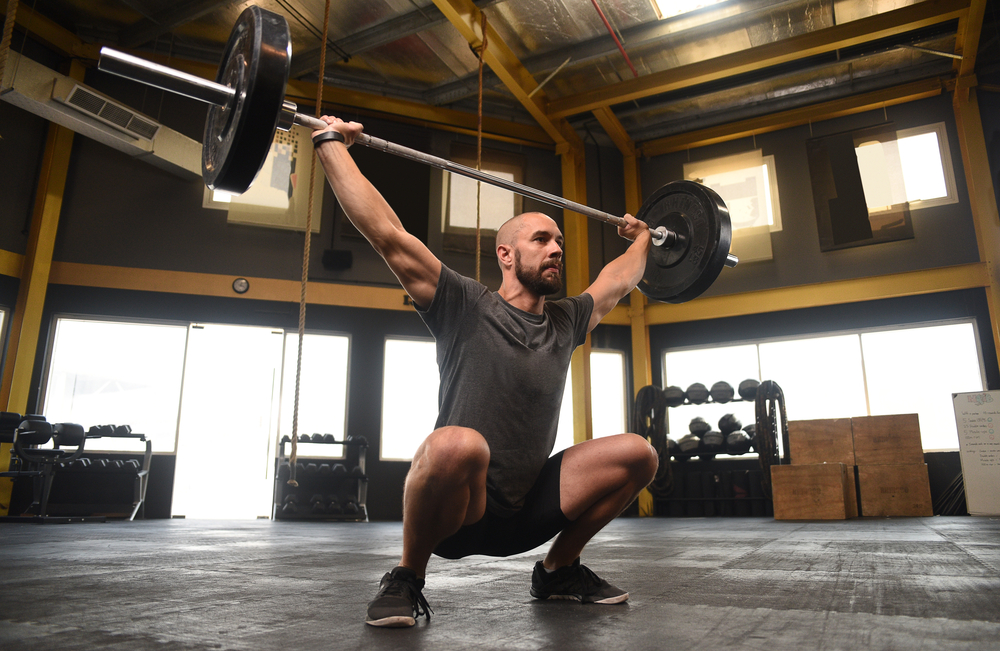
To do overhead squats, you would need a barbell or medicine ball. Unlike jumping squats, this workout targets muscles in your upper back, shoulders, and arms. The range of motion in this squat varies slightly, thus you need to be more careful while performing the overhead squats.
Step 1 - Stand straight upright and position your feet slightly wider than the shoulder width apart.
Step 2 - Grip the medicine ball above your head at all times during the exercise.
Step 3 - Starting with the standing position, bend your knees and move your hip slightly backward as you would do to acquire a normal squat position.
Step 4 - Stop when your thighs are aligned parallel to the ground.
Step 5 - Hold your body in the squat position for a few seconds.
Step 6 - Bring your heels to the starting position.
These are the three most common variations of jump squats. However, there are many other types of squats such as sumo squats, monkey squats, wall squats, uneven squats, etc.
Conclusion
Jump squats exercises are high-intensity workouts that aim at strengthening the core and the set of muscles in the glutes, quadriceps, hamstrings, hips, and thighs. This aerobic and cardio exercise helps burn more calories and shed excess fat across abs, hips, and legs while improving your body’s natural potential to balance and promote mobility. Performing squats every day is said to be beneficial for your body’s posture, and improves insulin resistance and glucose metabolism. When performed correctly, the functional exercise can prevent the risk of injuries and trigger testosterone for optimal muscle mass gain in men. Trying different variations of jumping squats may help you stay motivated and enjoy your regular workouts for maximum health benefits. Since you know the best benefits of jump squats, try out its different variations to improve athletic endurance and cut down the risk of cardiac and obesity-related health problems.
Contributor: Dr. Allen Conrad, BS, DC, CSCS, and Owner of Montgomery County Chiropractic Center
Sources
1. The Effects of Multiple Sets of Squats and Jump Squats on Mechanical Variables
https://pubmed.ncbi.nlm.nih.gov/28759537/
2. Jump-Squat and Half-Squat Exercises: Selective Influences on Speed-Power Performance of Elite Rugby Sevens Players
https://www.ncbi.nlm.nih.gov/pmc/articles/PMC5256944/
3. Power versus strength-power jump squat training: influence on the load-power relationship
https://pubmed.ncbi.nlm.nih.gov/17545891/
4. Comparison of Core Muscle Activation between a Prone Bridge and 6-RM Back Squats
https://www.ncbi.nlm.nih.gov/pmc/articles/PMC6006542/
5. Improved Maximum Strength, Vertical Jump and Sprint Performance after 8 Weeks of Jump Squat Training with Individualized Loads
https://www.ncbi.nlm.nih.gov/pmc/articles/PMC4974862/
6. Exercise and type 2 diabetes: molecular mechanisms regulating glucose uptake in skeletal muscle
https://www.ncbi.nlm.nih.gov/pmc/articles/PMC4315445/
7. Exercise and Regulation of Lipid Metabolism
https://pubmed.ncbi.nlm.nih.gov/26477910/





 JOIN OUR WHATSAPP CHANNEL
JOIN OUR WHATSAPP CHANNEL



















































































